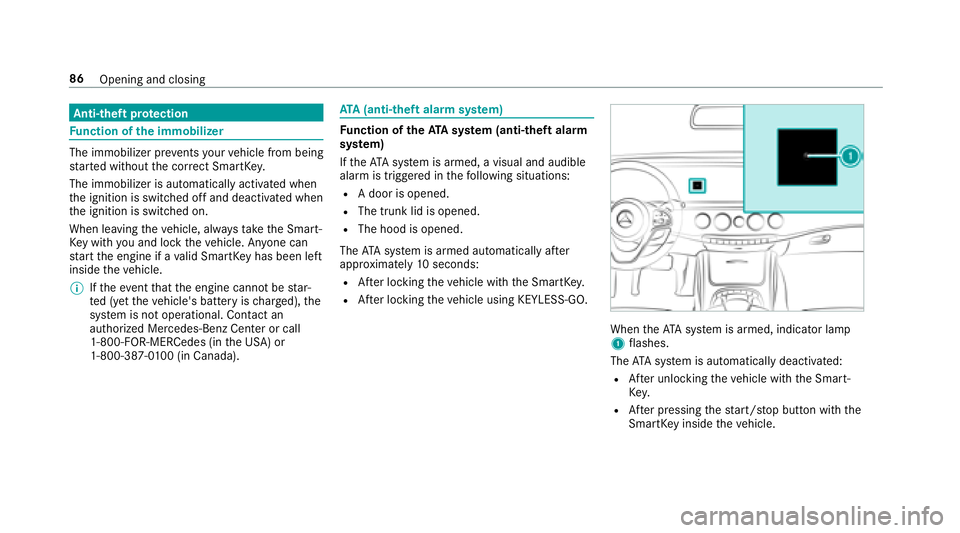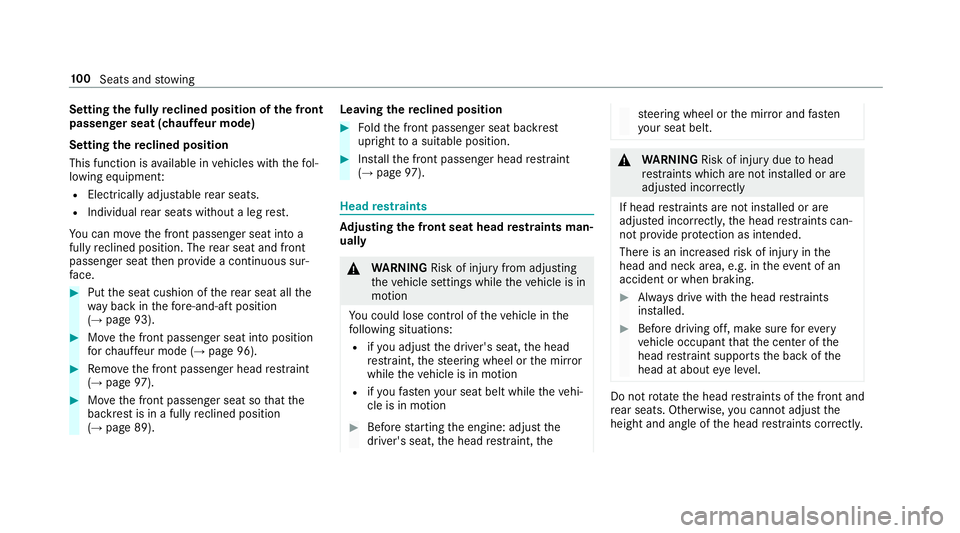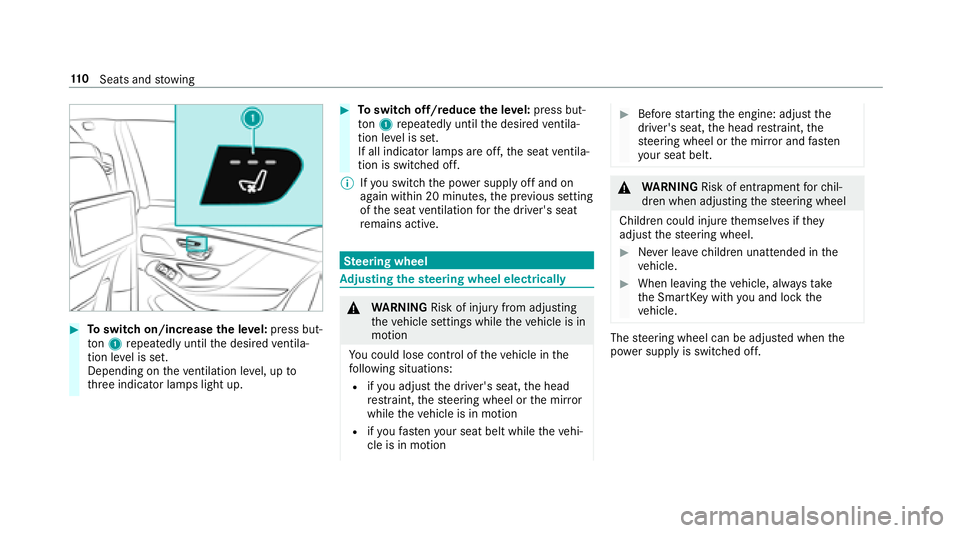2018 MERCEDES-BENZ S-CLASS SEDAN engine
[x] Cancel search: enginePage 60 of 562

SmartKey
Overview of SmartK eyfunctions
&
WARNING Risk of accident and injury
due tochildren left unatte nded inthe
ve hicle
If ch ildren are left unatte nded intheve hicle,
th ey could:
ROpen doo rs,th ereby endangering other
persons or road users
RGet out of theve hicle and be hit by
oncoming traf fic
ROperate vehicle equipment
In addition, thech ildren could also set the
ve hicle in motion, forex ample, by:
RRe leasing the parking brake
RShifting the transmission out of park
position j
RStarting the engine.
#Ne ver lea vechildren and animals unat‐
te nded in theve hicle.
#When leaving theve hicle, alw aysta ke
th e SmartK eywith you and lock the
ve hicle.
#Ke ep the SmartK eyout of there ach of
ch ildren.
* NO
TEDama getotheke ycaused by
magnetic fields
#Ke ep theke yaw ay from strong mag‐
netic fields.
1Loc ks
2Battery check lamp
3Unloc ks
4Opens/closes the trunk lid
5Pa nic alarm
The Smart Keyloc ksand unlo cksth efo llowing
components:
RDoo rs
RTrunk lid
RFu elfiller flap
If yo u do not open theve hicle within appr ox‐
imately 40 seconds af ter unlocking:
RThe vehicle is loc ked again.
RAnti- theft pr otection is reactivated.
Do not keep the SmartK eytoget her with elec‐
tronic devices or me tal objects. This can af fect
th e SmartK ey's functionality.
Do not keep the SmartK eyinthete mp erature-
controlled cup holder. Otherwise, the SmartK ey
will not be reliably de tected.
% If battery check lamp 2does not light up
af te r pressing the% or& button, the
battery is dischar ged.
58
Opening and closing
Page 68 of 562

#Tounlock :turn the mechanical keycounter -
clo ckwise toposition 1.
#Tolock: turnthe mechanical keyclo ckwise
to position 1.
#Carefully press the co ver onto the lock cylin‐
der until it engages and is seated firm ly.
Tr unk
Opening the trunk lid
&
WARNING Risk ofexhaust gas poisoning
Combustion engines emit poisonous exhaust
ga ses such as carbon monoxide. Exhaust
ga ses can enter theve hicle interior if the
trunk lid is open when the engine is running,
especially if theve hicle is in motion.
#Alw ays switch off the engine before
opening the trunk lid.
#Ne ver drive with the trunk lid open.
* NO
TEDama getothe trunk lid byobs ta‐
cles ab ovetheve hicle
The trunk lid swings upwards when it is
opened.
#Therefore, make sure that there is suf fi‐
cient clearance ab ovethe trunk lid.
Yo u ha vethefo llowing options toopen the trunk
lid:
#Pull the trunk lid handle.
#Ve hicles with trunk lid co nvenience clos‐
ing: With th e trunk lid stopped in an inter‐
mediate position, pull the trunk lid upwards
and release as soon as it begins toopen.
#Press and hold thep button on the
SmartK ey.
#Pull trunk lid remo teoperating switch 1.
66
Opening and closing
Page 88 of 562

Anti-theft protection
Fu nction of the immobilizer
The immobilizer pr events your vehicle from being
st ar ted without the cor rect SmartK ey.
The immobilizer is automatically activated when
th e ignition is switched off and deactivated when
th e ignition is switched on.
When leaving theve hicle, alw aysta ke the Smart‐
Ke ywit hyo u and lock theve hicle. An yone can
st art the engine if a valid SmartK eyhas been left
inside theve hicle.
% Ifth eeve ntthat the engine cannot bestar‐
te d (y ettheve hicle's battery is charge d), the
sy stem is not operational. Contact an
authorized Mercedes-Benz Center or call
1-800-FO R-MERCedes (in the USA) or
1-800-387-0 100 (in Canada).
ATA (anti-theft alarm system)
Fu nction of theATA system (anti-theft ala rm
sy stem)
If th eATA system is armed, a visual and audible
alarm is triggered in thefo llowing situations:
RA door is opened.
RThe trunk lid is opened.
RThe hood is opened.
The ATA sy stem is armed automatically af ter
appr oximately 10seconds:
RAfter locking theve hicle with the SmartK ey.
RAf ter locking theve hicle using KEYLESS-GO.
When theATA system is armed, indicator lamp
1 flashes.
The ATA sy stem is automatically deactivated:
RAf ter unlocking theve hicle with the Smart‐
Ke y.
RAfter pressing thest art/ stop button with the
SmartK eyinside theve hicle.
86
Opening and closing
Page 90 of 562

Notes onthe cor rect driver's seat position
&
WARNING Risk of injury from adjusting
th eve hicle settings while theve hicle is in
motion
Yo u could lose cont rol of theve hicle in the
fo llowing situations:
Rifyo u adjust the driver's seat, the head
re stra int, thesteering wheel or the mir ror
while theve hicle is in motion
Rifyo ufa sten your seat belt while theve hi‐
cle is in motion
#Before starting the engine: adjust the
driver's seat, the head restra int, the
st eering wheel or the mir ror and fasten
yo ur seat belt.
Obser vethefo llowing when adjusting steering
wheel 1, seat belt 2and driver's seat 3:
Ryou are as faraw ay from the driver's airbag
as possible
Ryo u are sitting in a no rmal upright position
Ryour thighs are slightly supportedby the seat
cushion
Ryo ur legs are not entirely stre tched and you
can dep ress the pedals properly
Rthe back of your head is support ed ateye
le ve lby the center of the head restra int
Ryo u can hold thesteering wheel with your
arms slightly bent
Ryo u can mo veyour legs freely
Ryou can see all the displa ysinthe instrument
clus ter clearl y
Ryou should ha vea good overview of traf fic
conditions
Rth e seat belt is pulled snugly against the
body and must be routed across the center
of your shoulder and across your hips in the
pelvic area
88 Seats and stowing
Page 91 of 562

Seats
Adjusting the front seat electrically
&
WARNING Risk of becoming trapped if
th e seats are adjus tedby children
Children could become trapped if they adjust
th e seats, particularly when unattended.
#When leaving theve hicle, alw aysta ke
th e SmartK eywith you and lock the
ve hicle.
#Ne ver lea vechildren unatte nded inthe
ve hicle.
The seats can be adjus ted when the ignition is
switched off.
& WARNING Risk of becoming trapped
when adjusting the seats
When you adjust a seat, you or other vehicle
occupants could become trapped, e.g. on the
seat guide rail.
#Make sure when adjusting a seat that
no one has any body parts in the sweep
of the seat.
Obser vethe saf etyno tes on "Air bags" and "Chil‐
dren in theve hicle".
&
WARNING Risk of injury from adjusting
th eve hicle settings while theve hicle is in
motion
Yo u could lose cont rol of theve hicle in the
fo llowing situations:
Rifyo u adjust the driver's seat, the head
re stra int, thesteering wheel or the mir ror
while theve hicle is in motion
Rifyo ufa sten your seat belt while theve hi‐
cle is in motion
#Before starting the engine: adjust the
driver's seat, the head restra int, the
st eering wheel or the mir ror and fasten
yo ur seat belt.
&
WARNING Risk of becoming trapped if
th e seat height is adjus ted carelessly
If yo u adjust the seat height carelessly, you
or other vehicle occupants could be trapped
and thereby injured.
Children in particular could accidenta lly
press the electrical seat adjustment buttons
and become trapped.
#While moving the seats, make sure that
hands or other body parts do not get
under the le ver assembly of the seat
adjustment sy stem.
&
WARNING Risk of injury duetohead
re stra ints which are not ins talled or are
adjus ted incor rectly
If head restra ints are not ins talled or are
adjus ted incor rectly, the head restra ints can‐
not pr ovide pr otection as intended.
There is an increased risk of injury in the
head and neck area, e.g. in theeve nt of an
accident or when braking.
Seats and stowing 89
Page 102 of 562

Settingthe fully reclined position of the front
passenger seat (chau ffeur mode)
Setting there clined position
This function is available in vehicles with thefo l‐
lowing equipment:
RElectrically adjus table rear seats.
RIndividual rear seats without a leg rest.
Yo u can mo vethe front passenger seat into a
fully reclined position. The rear seat and front
passenger seat then pr ovide a continuous sur‐
fa ce.
#Put the seat cushion of there ar seat all the
wa ybac kin thefo re -and-aft position
(
→pa ge 93).
#Mo vethe front passenger seat into position
fo rch auf feur mode (→page 96).
#Re mo vethe front passenger head restra int
(→page 97).
#Mo vethe front passenger seat so that the
backrest is in a fully reclined position
(
→page 89). Leaving the
reclined position
#Fo ldthe front passenger seat backrest
upright toa suitable position.
#Inst allthe front passenger head restra int
(→page 97).
Head restra ints
Ad justing the front seat head restra ints man‐
ually
& WARNING Risk of injury from adjusting
th eve hicle settings while theve hicle is in
motion
Yo u could lose cont rol of theve hicle in the
fo llowing situations:
Rifyo u adjust the driver's seat, the head
re stra int, thesteering wheel or the mir ror
while theve hicle is in motion
Rifyo ufa sten your seat belt while theve hi‐
cle is in motion
#Before starting the engine: adjust the
driver's seat, the head restra int, the
steering wheel or the mir ror and fasten
yo ur seat belt.
&
WARNING Risk of injury duetohead
re stra ints which are not ins talled or are
adjus ted incor rectly
If head restra ints are not ins talled or are
adjus ted incor rectly, the head restra ints can‐
not pr ovide pr otection as intended.
There is an increased risk of injury in the
head and neck area, e.g. in theeve nt of an
accident or when braking.
#Alw ays drive with the head restra ints
ins talled.
#Before driving off, make sure forev ery
ve hicle occupant that the center of the
head restra int supports the back of the
head at about eye le vel.
Do not rotate the head restra ints of the front and
re ar seats. Otherwise, you cannot adjust the
height and angle of the head restra ints cor rectl y.
10 0
Seats and stowing
Page 112 of 562

#Toswitch on/increase the le vel:press but‐
to n1 repeatedly until the desired ventila‐
tion le vel is set.
Depending on theve ntilation le vel, up to
th re e indicator lamps light up.
#To switch off/reduce the le vel:press but‐
to n1 repeatedly until the desired ventila‐
tion le vel is set.
If all indicator lamps are off, the seat ventila‐
tion is switched off.
% Ifyo uswit ch th e power supply off and on
again within 20 minutes, the pr evious setting
of the seat ventilation forth e driver's seat
re mains active.
Ste ering wheel
Adjusting the steering wheel electrically
&
WARNING Risk of injury from adjusting
th eve hicle settings while theve hicle is in
motion
Yo u could lose cont rol of theve hicle in the
fo llowing situations:
Rifyo u adjust the driver's seat, the head
re stra int, thesteering wheel or the mir ror
while theve hicle is in motion
Rifyo ufa sten your seat belt while theve hi‐
cle is in motion
#Before starting the engine: adjust the
driver's seat, the head restra int, the
st eering wheel or the mir ror and fasten
yo ur seat belt.
&
WARNING Risk of entrapment forch il‐
dren when adjusting thesteering wheel
Children could injure themselves if they
adjust thesteering wheel.
#Ne ver lea vechildren unatte nded inthe
ve hicle.
#When leaving theve hicle, alw aysta ke
th e SmartK eywith you and lock the
ve hicle.
The steering wheel can be adjus ted when the
po we r supp lyis switched off.
11 0
Seats and stowing
Page 120 of 562

Calling up
#Press button1.
When the indicator lamp lights up, the front
passenger seat is selected.
Example: vehicles without reclining rear seat
#Press and hold there leva nt preset position
button 1,2 or 3 until bo thseats are in the
st ored position.
% The preset positions in the area forth e
ch auf feur mode can only be se twhen the
conditions forth ech auf feur mode are fulfil‐
led (
→page 95 ). %
Seat adjustment is inter rupte d as soon as
yo ure lease the preset position button.
The adjustment of the active multicon tour
seat is still car ried out.
% You can use there ar passenger compart‐
ment child saf etyloc kto deactivate this
function (
→page 56).
St ow age areas
Note s on loading theve hicle
&
WARNING Risk ofexhaust gas poisoning
Combustion engines emit poisonous exhaust
ga ses such as carbon monoxide. Exhaust
ga ses can enter theve hicle interior if the
trunk lid is open when the engine is running,
especially if theve hicle is in motion.
#Alw ays switch off the engine before
opening the trunk lid.
#Ne ver drive with the trunk lid open.
11 8
Seats and stowing